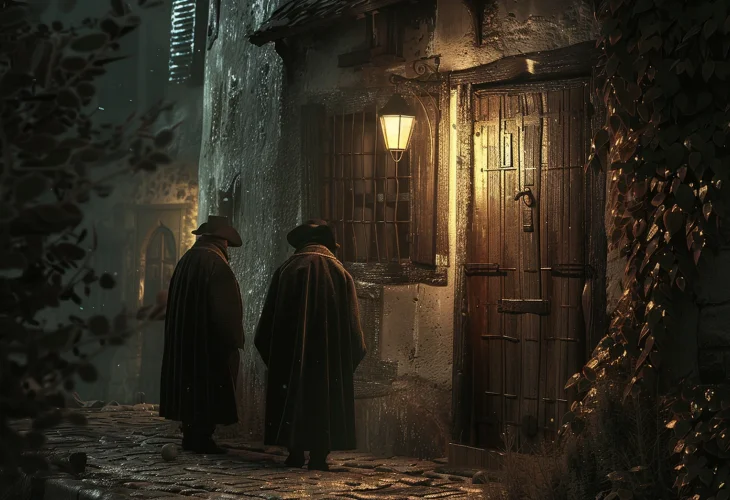The Great Heist of Eisenstadt: Will the Truth Ever Surface?
One midnight, two Jewish men knocked on his door. They confessed to stealing a large sum of money from a nobleman and argued over how to divide the loot. They demanded the rabbi rule on the matter, forcing him to swear not to report them.

The town of Eisenstadt, about three hundred years ago. Loud voices of argument could be heard at the entrance of a Jewish merchant's home, Rabbi Itzel. His servant was sent to Count Esterhazy's castle to collect payment due for the annual horse trade, "precious stones worth six thousand." The master had prepared him in advance, sewing a special inner pocket and instructing him on his conduct. Rabbi Itzel had trusted him for years, but now he returned without the money. According to him, the money fell and was lost. Perhaps the pocket was not sewn properly. Rabbi Itzel refused to accept such a childish excuse, akin to "the dog ate my homework," and demanded he reveal the money's location. The servant feigned innocence, inviting Rabbi Itzel to search his room, clothes, and everywhere he liked.
People gathered around. Rabbi Itzel insisted: he must be handed over to the police; they will teach him a lesson with their interrogation methods. Others argued: Absolutely not! That's a complete betrayal, and there are no proofs. Can you hand a Jew over to secular courts without evidence? The dispute flared up with full force. Meanwhile, the servant was detained in the community building, but no decision was reached because the town's rabbi was absent, forced to flee.
It's important to know that the Eisenstadt community was the center of an independent Jewish autonomy called "The Seven Communities." These communities were located in the Burgenland region, then part of Hungary (now Austria). This was an independent region owned by the Esterhazy noble family and other aristocratic families, who granted Jews full autonomy, allowing them to advance commerce and supply their needs. Over time, five more communities joined the seven, but the name "Seven Communities" remained.
The rabbi of the Seven Communities was Rabbi Meir of Eisenstadt, named after his position, a Torah great and a man of renown, nephew of the famous genius the Shach, student of the "Magen Avraham" and Rabbi David Oppenheim, and mentor of Rabbi Yehonatan Eybeschutz. Rabbi Meir was a quick responder and wrote thousands of answers sent across the land, later published in the "Panim Meirot" series. He was born in Poznań, but the burden of inquiries there was heavy, so he sought a position more in line with his methods. With the help of Minister Rabbi Samson Wertheimer, Rabbi Meir obtained the rabbinate of the Seven Communities.
Why was the Eisenstadt rabbi absent?
One midnight, two Jewish men knocked on his door. They confessed to stealing a large sum of money from a nobleman and argued over how to divide the loot. They demanded the rabbi rule on the matter, forcing him to swear not to report them. The rabbi was compelled to comply, but the news spread that the thieves had visited his home, and he had to flee to his birthplace, Poznań, knowing suspicion would fall on him. Indeed, the authorities confiscated his property. The rabbi remained absent from his city for a long time but continued providing written responses. In one letter from that time, he wrote: "I delivered a sermon of moral reproof to the people in the festive gathering of the month of Menachem 5783. When I left, this is the exile in the Polish lands due to informers." And in another response, he wrote: "Praying with a broken heart, distressed, that I be saved from false tongues."
The question also about the servant, suspected but without evidence, was sent to him in writing, and Rabbi Meir replied: "It is permissible to chastise and torment him until he confesses, as there is concern they might learn from his actions, and more rebels against their masters will arise." He cites as evidence the famous Talmudic story of Mar Zutra the Pious, whose silver vessel was stolen. When one of the students was seen drying his hands on another's garment, suspicion fell upon him, leading to his confession after punishment.
He also recounts a story from his uncle, from the time of the Shach, when his master, Rabbi Heshel, entrusted him with a gold chain, which was then stolen. Both the rabbi and the student agreed to punish him until he confessed, placing his hand in a vice, yet he did not confess. Only later was the theft found in his possession, affirming they were right to suspect him.
We don't know what became of Rabbi Itzel's merchant money, but Rabbi Meir of Eisenstadt was vindicated from the false accusation. One thief confessed to coercing the rabbi to divide the loot, proving the rabbi's innocence. He returned to his city, where he lived a long and honorable life.

